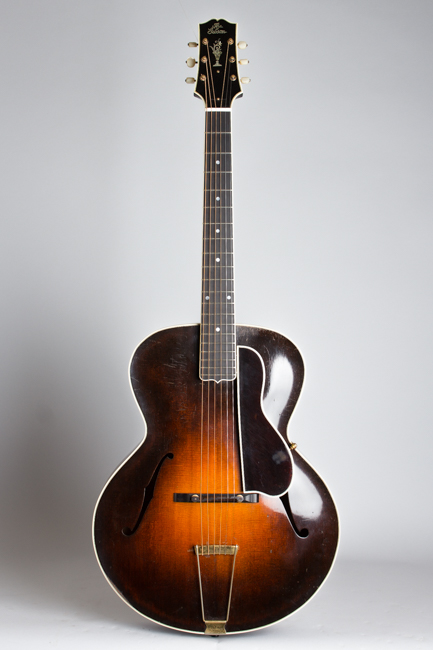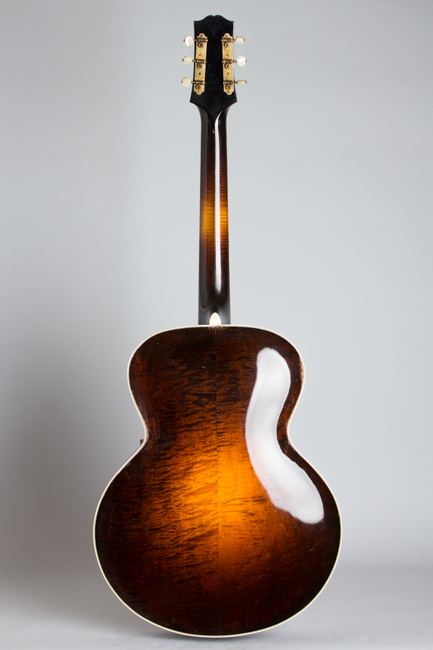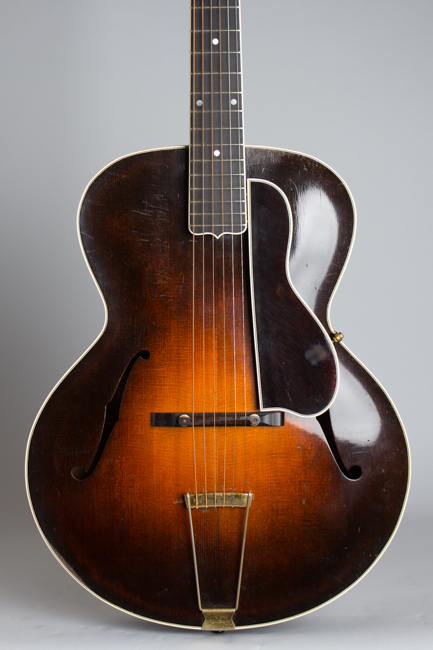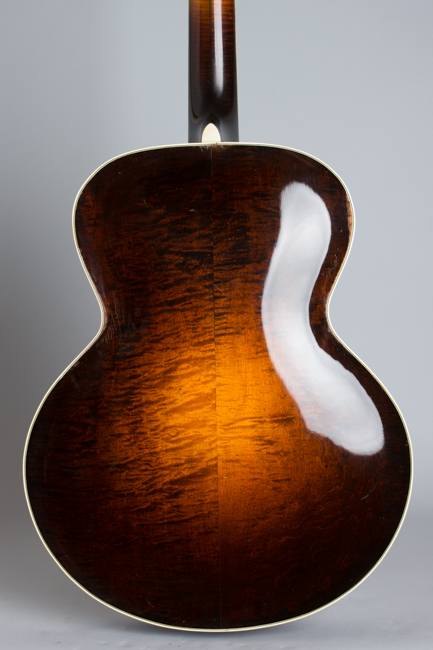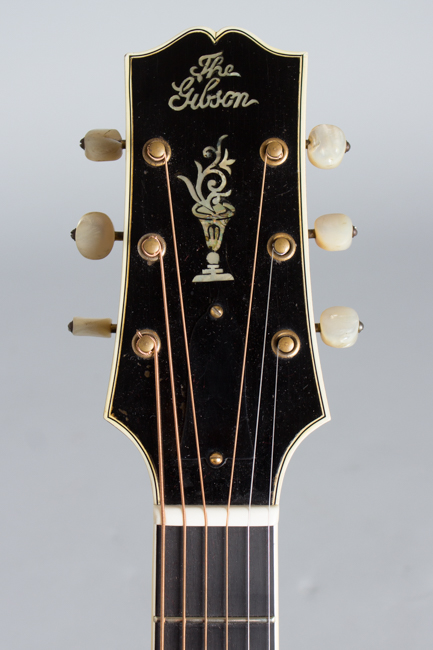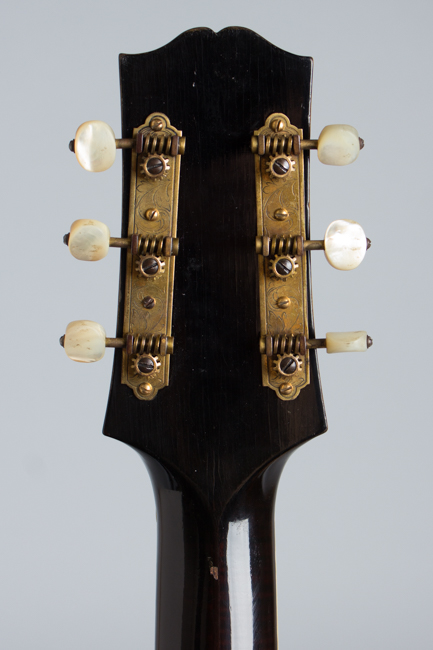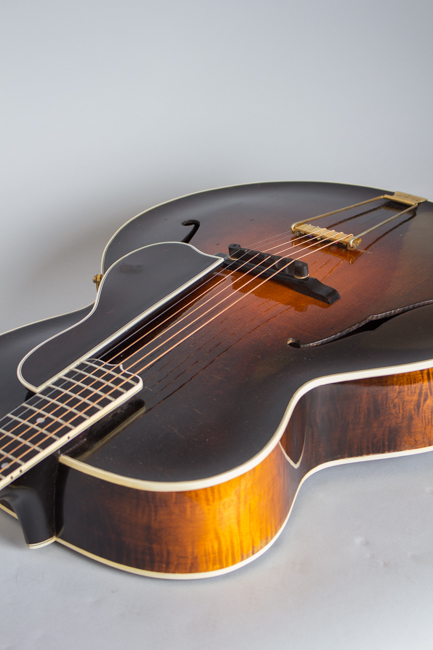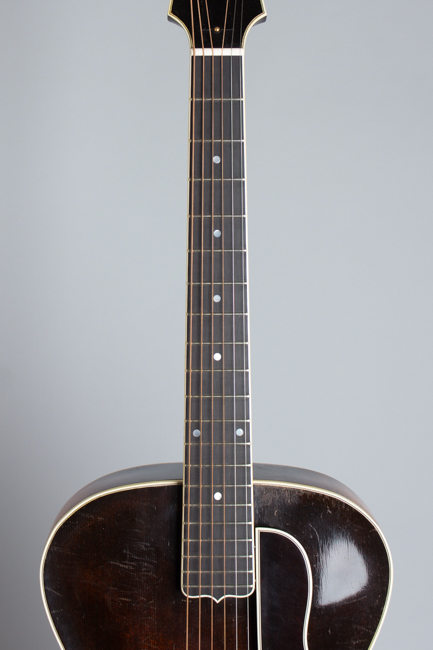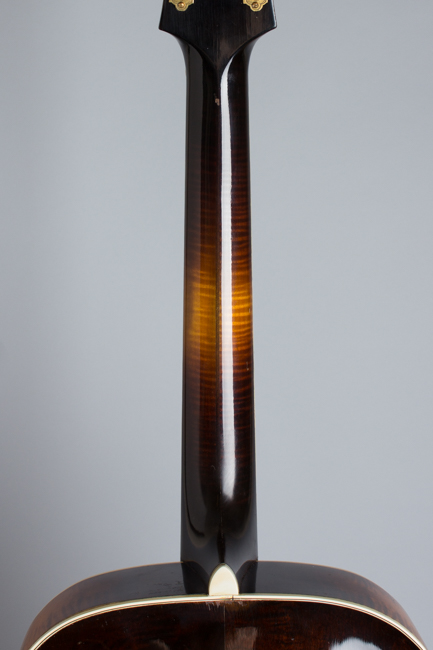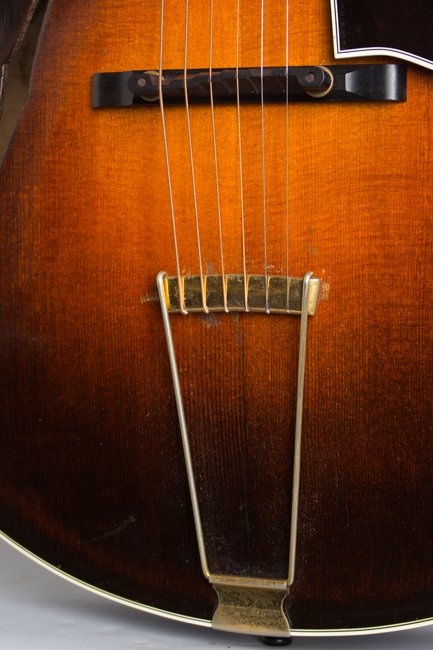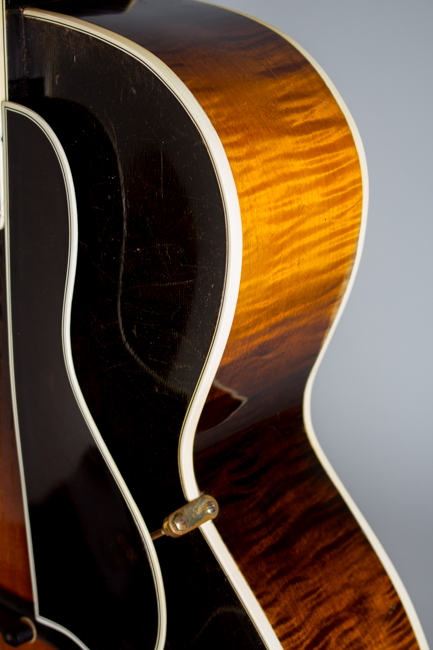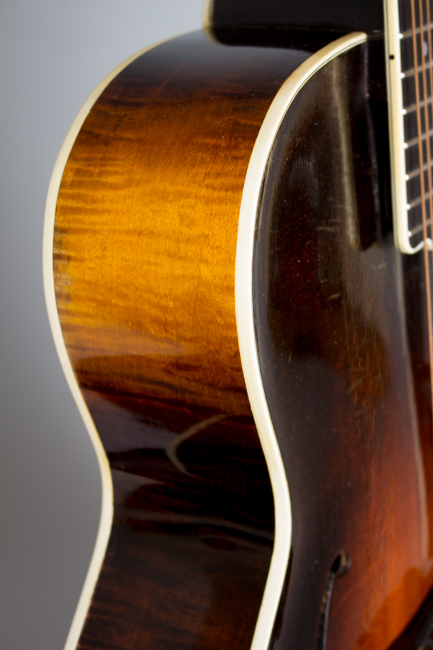Gibson L-5 Arch Top Acoustic Guitar (1931)
This item has been sold.
Item # 7940
Prices subject to change without notice.
Gibson L-5 Model Arch Top Acoustic Guitar (1931), made in Kalamazoo, Michigan, serial # 87479, Cremona Brown Sunburst finish, spruce top, maple sides and neck, birch back, ebony fingerboard, original black hard shell case.
This original dot-neck L-5 is simply a fantastic example; an important guitar historically and also an extremely fine-playing and exceptional-sounding instrument. Designed by the Gibson team headed up by Lloyd Loar and debuting in 1923-4, the L-5 was the original archetype for the modern arch-top guitar. The combination of features it offered -- a carved, arched spruce top with f-holes; 14-fret neck joint; elevated fingerboard; adjustable truss rod and bridge; elevated pickguard -- made it a unique instrument with no peers anywhere when introduced.
At the time this one was sold, it was still the ONLY such f-hole carved-top guitar in existence. As orchestra banjoists were beginning to convert to guitar for at least part of their repertoire, the L-5, along with Gibson's oval-hole 16" L-4, rapidly proved to be the only really useful guitars in this setting.
Eddie Lang, the most influential guitarist of the era, changed over from a 1920s L-4 to a dot-neck L-5 (probably a 1927-8) to an early block neck L-5 by 1930, setting the trend for many other guitarists and banjoists-turned-guitarists to follow. While several other companies brought arch-top guitars to market beginning in 1928-9, it was not until the mid/late 1931 introduction of the Epiphone Masterbilt line that another truly comparable guitar was available. In the meantime, the L-5 ruled the roost for professional orchestra guitar players, giving Gibson a dominance that the company never really lost.
That said, these early pattern L-5s are very rare guitars today. Retailing at $275.00 (plus case!), the L-5 was the most expensive guitar in the world by a fair margin…even a top-of-the-line Martin pearl-trimmed Style 45 retailed around $100.00 less. Only the top professional players could afford the indulgence of such an instrument.
Most surviving 16" L-5s were used extensively over many years, some owners continuing to prefer them to any other guitars. These older L-5s are often seen in the hands of recording specialists well into the 1960s. As working instruments, many (if not most) have been modified, refitted, or refinished…to find a an early L-5 in such clean original condition is a rare treat!
The dating of these "post-Loar", pre-block inlay 1929-1933 Gibson L-5s has recently been studied and cataloged in much finer detail than before. By the "old" reckoning, this guitar would have been considered a 1929 example. It still carries the "old" Loar-era features that started to change around the turn of the decade from the '20s to the '30s, when the L-5 began to be produced in larger numbers. By more recent scholarship (thanks mostly to researcher Joe Spann's re-examination of Gibson chronology), it appears to have been shipped in mid-1931.
The serial numbers for L-5s from this period are very inconsistent. Some guitars with the "later" features like the square-end, block inlaid fingerboard and longer pickguard carry numbers quite a bit lower in sequence than some (like this one) that still have the original 1920s elements. This information shows this guitar -- #87479 -- to be part of one of the last batches of original style dot-marker L-5s that Gibson assembled and sold in 1931, during the worst part of the Depression.
The features of this guitar are the classic "post-Loar" type seen on L-5 guitars from 1925-31. All surfaces are finished in a beautiful Cremona brown sunburst, showing off the flamey maple grain. The finish is lacquer, just a bit thicker than the 1925 and earlier varnish. One feature of this guitar hidden from view is the bracing; right around the time this guitar was made, Gibson began to take a shortcut, mounting the two parallel top braces. The brace would be "kerfed", that is, have small cuts in the underside so it could be more quickly laid into place under the top without so much hand-fitting. This guitar still retains the older-style hand-carved braces, fitted in the original way, which is considered to enhance the tonal qualities of the top.
The laminated curly maple neck on this guitar has a rounder, slightly shallower profile overall than many examples, with a dot-inlaid ebony fingerboard with a point at the end and side binding. The tuners are gold-plated, pearl button engraved Waverly strips, but the nut is bone instead of pearl. The pearl "The Gibson" logo is mounted straight across the headstock, above the L-5's signature flowerpot inlay. The gold-plated tailpiece is the original style with the strings feeding over the bar, and the triple-bound celluloid pickguard is the older "short" type, pinned to the side of the neck.
This particular guitar plays perfectly and has a spectacular sound typical of the best 16" L-5s; it is simultaneously warm and incisive with plenty of volume and depth. These guitars are among the most responsive of arch-tops, and this one sounds quite good fingerstyle! We think this is one of the finest-looking, playing, and sounding L-5s we have heard, and a truly spectacular find.
Overall length is 41 1/4 in. (104.8 cm.), 16 in. (40.6 cm.) wide at lower bout, and 3 1/4 in. (8.2 cm.) in depth at side, taken at the end block. Scale length is 24 3/4 in. (629 mm.).
Overall this is the best preserved of these early L-5s we have seen in a long time. The instrument shows some typical light finish wear and checking overall, but there is no heavy playwear, just some light strumming marks on the top above and below the strings near the fingerboard. All finish and parts are original, and the gold plating has some light wear spots as well. The pearl tuner buttons have a couple of small chips but function as they should, and the original ebony bridge top has been lowered a bit on the bottom.
There has been one major restoration; when we found this instrument, the fingerboard had been inset with fairly crude versions of Gibson's 1930s pearl block inlay, probably by the original owner who perhaps felt slighted that it didn't come that way originally! As the structure of the board had been somewhat compromised by this, it has been entirely replaced with a perfect replica ebony fingerboard with the correct style pearl dots, frets, and side-line inlay. The work is exceptionally clean and the guitar is now perfectly restored to its original state.
Other than this work the instrument is unaltered and plays and sounds as it should, indeed as it did in 1931, but with the added mellowing of almost 90 years of aging thrown in. We think the early L-5 is one of the greatest and most important of all 20th century guitars; beyond this, it is also one of the ultimate player's instruments. Although typecast as a "jazz" guitar, any style of music is enhanced by this instrument; indeed, many early country players (especially Maybelle Carter and Carson Robison) used them extensively. This wonderful guitar is still accompanied by its original case, which has a period canvas cover made for it when new still semi-intact. Excellent Condition.
This original dot-neck L-5 is simply a fantastic example; an important guitar historically and also an extremely fine-playing and exceptional-sounding instrument. Designed by the Gibson team headed up by Lloyd Loar and debuting in 1923-4, the L-5 was the original archetype for the modern arch-top guitar. The combination of features it offered -- a carved, arched spruce top with f-holes; 14-fret neck joint; elevated fingerboard; adjustable truss rod and bridge; elevated pickguard -- made it a unique instrument with no peers anywhere when introduced.
At the time this one was sold, it was still the ONLY such f-hole carved-top guitar in existence. As orchestra banjoists were beginning to convert to guitar for at least part of their repertoire, the L-5, along with Gibson's oval-hole 16" L-4, rapidly proved to be the only really useful guitars in this setting.
Eddie Lang, the most influential guitarist of the era, changed over from a 1920s L-4 to a dot-neck L-5 (probably a 1927-8) to an early block neck L-5 by 1930, setting the trend for many other guitarists and banjoists-turned-guitarists to follow. While several other companies brought arch-top guitars to market beginning in 1928-9, it was not until the mid/late 1931 introduction of the Epiphone Masterbilt line that another truly comparable guitar was available. In the meantime, the L-5 ruled the roost for professional orchestra guitar players, giving Gibson a dominance that the company never really lost.
That said, these early pattern L-5s are very rare guitars today. Retailing at $275.00 (plus case!), the L-5 was the most expensive guitar in the world by a fair margin…even a top-of-the-line Martin pearl-trimmed Style 45 retailed around $100.00 less. Only the top professional players could afford the indulgence of such an instrument.
Most surviving 16" L-5s were used extensively over many years, some owners continuing to prefer them to any other guitars. These older L-5s are often seen in the hands of recording specialists well into the 1960s. As working instruments, many (if not most) have been modified, refitted, or refinished…to find a an early L-5 in such clean original condition is a rare treat!
The dating of these "post-Loar", pre-block inlay 1929-1933 Gibson L-5s has recently been studied and cataloged in much finer detail than before. By the "old" reckoning, this guitar would have been considered a 1929 example. It still carries the "old" Loar-era features that started to change around the turn of the decade from the '20s to the '30s, when the L-5 began to be produced in larger numbers. By more recent scholarship (thanks mostly to researcher Joe Spann's re-examination of Gibson chronology), it appears to have been shipped in mid-1931.
The serial numbers for L-5s from this period are very inconsistent. Some guitars with the "later" features like the square-end, block inlaid fingerboard and longer pickguard carry numbers quite a bit lower in sequence than some (like this one) that still have the original 1920s elements. This information shows this guitar -- #87479 -- to be part of one of the last batches of original style dot-marker L-5s that Gibson assembled and sold in 1931, during the worst part of the Depression.
The features of this guitar are the classic "post-Loar" type seen on L-5 guitars from 1925-31. All surfaces are finished in a beautiful Cremona brown sunburst, showing off the flamey maple grain. The finish is lacquer, just a bit thicker than the 1925 and earlier varnish. One feature of this guitar hidden from view is the bracing; right around the time this guitar was made, Gibson began to take a shortcut, mounting the two parallel top braces. The brace would be "kerfed", that is, have small cuts in the underside so it could be more quickly laid into place under the top without so much hand-fitting. This guitar still retains the older-style hand-carved braces, fitted in the original way, which is considered to enhance the tonal qualities of the top.
The laminated curly maple neck on this guitar has a rounder, slightly shallower profile overall than many examples, with a dot-inlaid ebony fingerboard with a point at the end and side binding. The tuners are gold-plated, pearl button engraved Waverly strips, but the nut is bone instead of pearl. The pearl "The Gibson" logo is mounted straight across the headstock, above the L-5's signature flowerpot inlay. The gold-plated tailpiece is the original style with the strings feeding over the bar, and the triple-bound celluloid pickguard is the older "short" type, pinned to the side of the neck.
This particular guitar plays perfectly and has a spectacular sound typical of the best 16" L-5s; it is simultaneously warm and incisive with plenty of volume and depth. These guitars are among the most responsive of arch-tops, and this one sounds quite good fingerstyle! We think this is one of the finest-looking, playing, and sounding L-5s we have heard, and a truly spectacular find.
Overall length is 41 1/4 in. (104.8 cm.), 16 in. (40.6 cm.) wide at lower bout, and 3 1/4 in. (8.2 cm.) in depth at side, taken at the end block. Scale length is 24 3/4 in. (629 mm.).
Overall this is the best preserved of these early L-5s we have seen in a long time. The instrument shows some typical light finish wear and checking overall, but there is no heavy playwear, just some light strumming marks on the top above and below the strings near the fingerboard. All finish and parts are original, and the gold plating has some light wear spots as well. The pearl tuner buttons have a couple of small chips but function as they should, and the original ebony bridge top has been lowered a bit on the bottom.
There has been one major restoration; when we found this instrument, the fingerboard had been inset with fairly crude versions of Gibson's 1930s pearl block inlay, probably by the original owner who perhaps felt slighted that it didn't come that way originally! As the structure of the board had been somewhat compromised by this, it has been entirely replaced with a perfect replica ebony fingerboard with the correct style pearl dots, frets, and side-line inlay. The work is exceptionally clean and the guitar is now perfectly restored to its original state.
Other than this work the instrument is unaltered and plays and sounds as it should, indeed as it did in 1931, but with the added mellowing of almost 90 years of aging thrown in. We think the early L-5 is one of the greatest and most important of all 20th century guitars; beyond this, it is also one of the ultimate player's instruments. Although typecast as a "jazz" guitar, any style of music is enhanced by this instrument; indeed, many early country players (especially Maybelle Carter and Carson Robison) used them extensively. This wonderful guitar is still accompanied by its original case, which has a period canvas cover made for it when new still semi-intact. Excellent Condition.
